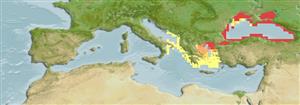Common names from other countries
>
Gobiiformes (Gobies) >
Gobiidae (Gobies) > Gobiinae
Etymology: Proterorhinus: Greek, proteros = former + Greek, rhinos = nose (Ref. 45335).
More on author: Pallas.
Issue
Name should be changed to Proterorhinus semilunaris Heckel 1837 according to: Stepien C.A. & M.A. Tumeo, 2006: Invasion Genetics of Ponto-Caspian Gobies in the Great Lakes: A ‘Cryptic’ Species, Absence of Founder Effects, and Comparative Risk Analy
Environment: milieu / climate zone / depth range / distribution range
Ecologia
marinhas; Água doce; estuarina demersal; pH range: 7.0 - 7.5; dH range: 10 - ?; anfídromo (Ref. 46888). Temperate; 4°C - 18°C (Ref. 2060); 60°N - 36°N, 17°E - 54°E
Eurasia: rivers and estuaries of Black Sea, Sea of Azov and Caspian Sea, including tributaries. In the Mediterranean, occurs only in the Evros and Strymon systems, which empty in the northern Aegean Sea.
Tamanho / Peso / Idade
Maturity: Lm ? range ? - ? cm
Max length : 11.5 cm TL macho/indeterminado; (Ref. 2058)
Espinhos dorsais (total): 7 - 8; Raios dorsais moles (total): 14-18; Espinhos anais 1; Raios anais moles: 12 - 15. Seven transverse suborbital rows, complete oculoscapular and preopercular lateral-line canals, scaled nape and as a distinctive autapomorphy, an elongate anterior nostril, which extends over the upper lip. Broad dark oblique banding across the body.
Pure inhabitant of brackish waters (Ref. 92840). Occur in rivers and estuaries (Ref. 4696). Based on morphological and molecular data, this species does not enter pure freshwater and inhabits brackish waters in Sevastopol, Crimea (Ref. 59043).
Life cycle and mating behavior
Maturidade | Reprodução | Desova | Ovos | Fecundidade | Larvas
Miller, P.J., 1990. The endurance of endemism: the Mediterranean freshwater gobies and their prospects for survival. J. Fish Biol. 37(Suppl.A):145-156. (Ref. 12215)
Categoria na Lista Vermelha da IUCN (Ref. 130435)
CITES (Ref. 128078)
Not Evaluated
Ameaça para o homem
Harmless
Utilização humana
Aquário: Espécies comerciais
Mais informação
ReferênciasAquaculturaPerfil para aquaculturaEstirpesGenéticaElectrophoresesHereditariedadeDoençasProcessamentoMass conversion
Ferramentas
Relatórios especiais
Descarregue XML
Fontes da internet
Estimates based on models
Preferred temperature (Ref.
115969): 11 - 18.3, mean 13.9 (based on 80 cells).
Phylogenetic diversity index (Ref.
82804): PD
50 = 0.5312 [Uniqueness, from 0.5 = low to 2.0 = high].
Bayesian length-weight: a=0.01000 (0.00606 - 0.01650), b=3.08 (2.94 - 3.22), in cm Total Length, based on LWR estimates for this species & (Sub)family-body (Ref.
93245).
Nível Trófico (Ref.
69278): 3.5 ±0.5 se; based on diet studies.
Resiliência (Ref.
120179): Elevada, tempo mínimo de duplicação da população menor que 15 meses (Assuming tm<=1).
Fishing Vulnerability (Ref.
59153): Low vulnerability (10 of 100).
